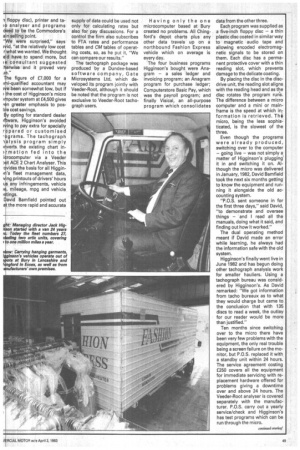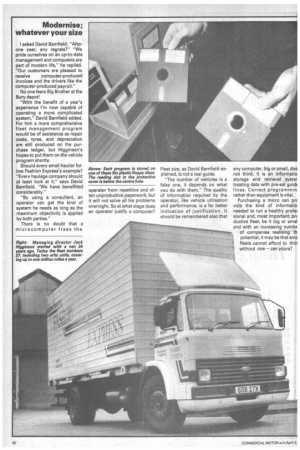Modernise: whatever your size of fleet
Page 46

Page 47

Page 48

If you've noticed an error in this article please click here to report it so we can fix it.
It's the quality of information required by an operator, not the number of vehicles he employs, that is the criterion by which computer justification is judged. Brian Weatherley explains
"COMPUTERS ARE only useful to large fleet operators." True or false? Many small hauliers do believe that modern business aids like computers are solely useful for those in "division one" of transport. Higginson's Deliveries knows that view is false.
Running a mixed fleet of 27 vehicles, Higginson's is not about to put the NFC out of business overnight. Yet like many small operators, it has bought its own computer.
Higginson's (trading name, Higginson's Fashion Express) distributes as far as Aberdeen and Falmouth for customers like Jean Jeanie and Richard Shops. Since starting in 1958, Higginson's business has expanded, bringing with it the not so wel come growth in book-keeping and paperwork.
Having vehicles based at customers' warehouses, or the Higginson's depots at • Bury and Chingford, meant that fleet information was widely disseminated. Processing it along with the normal accounting occupied two full-time members of staff and a part-time book-keeper.
"In transport you can always find something more important to do than writing up your books," said David Bamfield. Tachograph analysis was one area in particular that was not benefitting from manual reading of charts.
When it came to calculating.
running costs and, ultimately, rates, the company had to rely on the infrequent, audited accounts; they left a great deal to be desired.
"With.the audit once a year at best, we were six weeks out of
date; at worst it was 58 weeks out." With the company still growing, a centralised, more expert approach was needed.
The choice as David Bamfield saw it was either to recruit a full time semi-qualified accountant to produce the information required, or to go for a microcomputer with the same skills plus the benefit of tachograph analysis.
Before making a decision David and managing director Jack Higginson calculated the cost over a year of employing a new member of staff and arrived at the figure of £7,000. Using this sum David Bamfield set out to see if he could match it with the purchase of a micro plus software (or programs).
David sought the advice of a consultant, who produced a requirement sheet jointly with him and suggested two possible dealers, one of which was P.O.S. Computers of Wigan. Using the requirement sheet, P.O.S. arranged an active demonstration for David involving three leading makes — an Apple II, The Superbrain and the Commodore, a machine described by P.O.S. somewhat mysteriously as "user friendly".
"I was sceptical at first," says David, "but after I'd sat down with all three it did have a meaning to somebody like me who was totally new to it."
From a practical point of view the 8032 Commodore, according to David, had a better record of reliability, plus a comprehensive list of business programs that Higginson's could buy off the peg, including tacho analysis which would be suitable for producing the data required.
The availability of software and in particular the £4,500 price for micro, dual disc drive unit (each program being stored on a 1 floppy disc), printer and taanalyser and programs ed to be the Commodore's a n selling point.
Al e were surprised," says I id, "at the relatively low cost r what we wanted. We thought e d have to spend more, but I consultant suggested ervvise and it proved very
he figure of £7,000 for a i-qualified accountant may e been somewhat low, but if he cost of Higginson's micro outer system at £4,500 gives r n greater emphasis to pose cost savings.
y opting for standard dealer are, Higginson's avoided mg to pay extra for specially r pared or customised 'grams. The tachograph 1 lysis program simply veils the existing chart in) mation fed into the rocomputer via a Veeder t ACE 2 Chart Analyser. This vides the basis for all 's fleet management data, v ng printouts of drivers' hours u any infringements, vehicle I , mileage, mpg and vehicle tings.
avid Bamfield pointed out a the more rapid and accurate supply of data could be used not only for calculating rates but also for pay discussions. For a control the firm also subscribes to ETA rates and performance tables and CM tables of operating costs, so, as he put it, "We can compare our results."
The tachograph package was produced by a Dundee-based software company, Gate Microsystems Ltd, which developed its program jointly with Veeder-Root, although it should be noted that the program is not exclusive to Veeder-Root tachograph users. Having only the one microcomputer based at Bury created no problems. All Chingford's depot charts plus any other data travels up on a northbound Fashion Express vehicle which on average is everyday.
The four business programs Higginson's bought were Anagram — a sales ledger and invoicing program; an Anagram program for purchase ledger; Computerstore Basic Pay, which was the payroll program; and finally Visical, an all-purpose program which consolidates data from the other three.
Each program was supplied as a five-inch floppy disc — a thin plastic disc coated in similar way to magnetic audio tape and allowing encoded electromagnetic signals to be stored on them. Each disc has a permanent protective cover with a thin reading slot, which prevents damage to the delicate coating.
By placing the disc in the discdrive unit, the reading slot aligns with the reading head and as the disc rotates the program runs. The difference between a micro computer and a mini or mainframe is the speed at which in: formation is retrieved. The micro, being the less sophisticated, is the slowest of the three.
Even though the programs were already produced, switching over to the computer — going live — was not simply a. matter of Higginson's plugging it in and switching it on. Although the micro was delivered in January, 1982, David Bamfield took the next six months getting to know the equipment and running it alongside the old accounting system.
"P.O.S. sent someone in for the first three days," said David, "to demonstrate and oversee things — and I read all the manuals, doing what it said, and finding out how it worked."
The dual operating method meant if David made an error while learning, he always had the information safe with the old system.
Higginson's finally went live in June 1982 and has begun doing other tachograph analysis work for smaller hauliers. Using a tachograph bureau was considered by Higginson's. As David remarked: "We got information from tacho bureaux as to what they would charge but came to the conclusion that with 135 discs to read a week, the outlay for our reader would be more than justified."
Ten months since switching over to the micro there have been very few problems with the equipment, the only real trouble being a screen failure on the monitor, but P.O.S. replaced it with a standby unit within 24 hours. The service agreement costing £250 covers all the equipment for immediate servicing with replacement hardware offered for problems giving a downtime over and above 24 hours. The Veeder-Root analyser is covered separately with the manufacturer. P.O.S. carry out a yearly service/check and Higginson's has test programs which can be run through the micro. I asked David Bamfield: "After one year, any regrets?" "We pride ourselves on an up-to-date management and computers are part of modern life," he replied. "Our customers are pleased to receive computer-produced invoices and the drivers like the computer-produced payroll."
No one fears Big Brother at the Bury depot!
"With the benefit of a year's experience I'm now capable of operating a more complicated system," David Bamfield added. For him a more comprehensive fleet management program would be of assistance as repair costs, tyres, and depreciation are still produced on the purchase ledger, but Higginson's hopes to put them on the vehicle program shortly.
Should every small haulier follow Fashion Express's example? "Every haulage company should at least look at it," says David Bamfield. "We have benefitted considerably."
"By using a consultant, an operator can get the kind of system he needs as long as the maximum objectivity is applied by both parties."
There is no doubt that a microcomputer frees the operator from repetitive and often unproductive paperwork, but it will not solve all his problems overnight. So at what stage does an operator justify a computer? Fleet size, as David Bamfield explained, is not a real guide.
"The number of vehicles is a false one, it depends on what you do with them." The quality of information required by the operator, like vehicle utilisation and performance, is a far better indication of justification. It should be remembered also that any computer, big or small, doe not think. It is an informatio storage and retrieval syster treating data with pre-set guick lines. Correct prograrnmin rather than equipment is vital.
Purchasing a micro can prc vide the kind of informatio needed to run a healthy profe. sional and, most important, prc ductive fleet, be it big or smal and with an increasing numbE of companies realising th potential, it may be that sma fleets cannot afford to thin without one — can yours?












































































